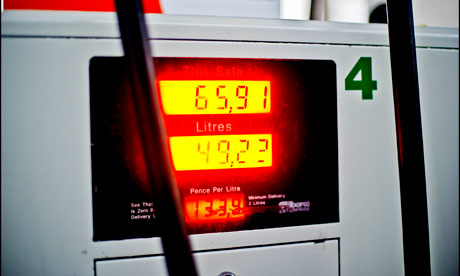
Britain's petrol forecourts are entering a "vicious circle" of falling demand and higher prices that could prove disastrous for the UK economy, the AA has warned.
With petrol and diesel prices again approaching the record highs seen last year, the AA, the motoring organisation, said the market in petrol was entering a dysfunctional phase. It said that although demand had fallen sharply, the cost of a litre of unleaded had risen to £1.33 following price rises from refiners coping with a 7% rise in the value of the dollar and falling profit margins.
The link between falling demand and downward movement of prices had been broken, the AA said, with punishing consequences for car drivers and hauliers.
The warning comes as eurozone consumers prepare to pay the highest petrol prices in history, despite the likely possibility of entering a second recession in three years that will further cut demand for petrol and diesel.
The rise in value of the dollar against the euro has sent oil costs, which are priced in dollars, soaring. Fears of a crisis in the single currency zone have sent the euro tumbling on world markets, while a strengthening US economy has pushed up the value of the dollar.
In Britain, petrol prices are nudging towards the high of £1.37 seen in May 2011 that led to protests by motorists and blockades of the country's biggest oil depots.
Ministers are understood to be investigating why prices are rising despite a period of falling demand, following calls last year in the US for an inquiry into the refining industry. Democratic senators called in May for a federal investigation to determine if US refiners were cutting production to keep pump prices high, pointing to what they said were unusually strong refinery profit margins and figures showing that plants were running at only 82% of their capacity – the lowest for the pre-summer driving season since 1985.
The International Energy Agency has released figures that show demand for oil slowing, following signs of weakness in the world economy. It said global consumption declined by 300,000 barrels a day during the final quarter of 2011.
In the agency's latest report it and has revised its outlook for growth in 2012 down to 1.1m barrels a day from 1.3m barrels a day.
Platts, the energy information provider, has reported that US gasoline consumption is down to 2003 levels.
Demand has also fallen sharply in the UK where the amount of fuel sold at the pumps declined by 2.4bn litres in the first three quarters of last year compared to the first three quarters of 2008.
AA spokesman Luke Bosdet said consumers were suffering because every fall in demand was being met by a cut in production and rise in prices, partly to offset higher import prices and partly to maintain profit margins at Britain's small group of independent refiners.
"There is a question over the direction of travel and whether this is now a vicious circle of falling demand and rising prices that does no one any good," he said.
In the last 10 years UK oil companies have sold their refining businesses to groups such as Ineos, which bought the Grangemouth refinery from BP and India's Essar Energy, which purchased the Stanlow refinery from Shell.

